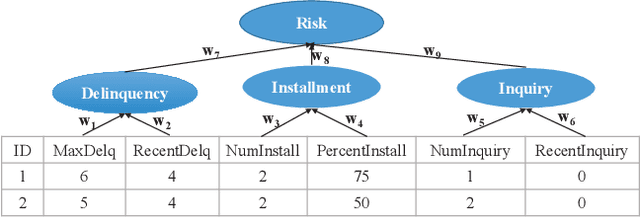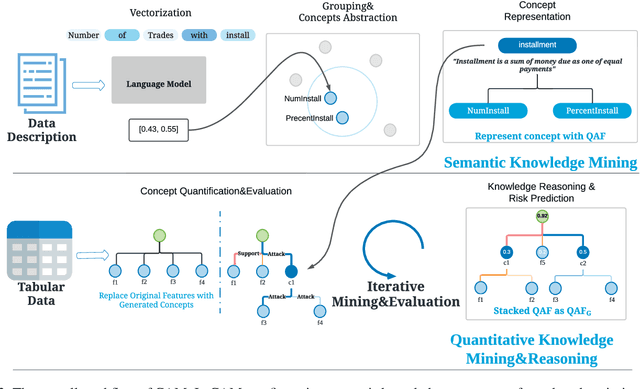Haixiao Chi
A Concept and Argumentation based Interpretable Model in High Risk Domains
Aug 17, 2022



Abstract:Interpretability has become an essential topic for artificial intelligence in some high-risk domains such as healthcare, bank and security. For commonly-used tabular data, traditional methods trained end-to-end machine learning models with numerical and categorical data only, and did not leverage human understandable knowledge such as data descriptions. Yet mining human-level knowledge from tabular data and using it for prediction remain a challenge. Therefore, we propose a concept and argumentation based model (CAM) that includes the following two components: a novel concept mining method to obtain human understandable concepts and their relations from both descriptions of features and the underlying data, and a quantitative argumentation-based method to do knowledge representation and reasoning. As a result of it, CAM provides decisions that are based on human-level knowledge and the reasoning process is intrinsically interpretable. Finally, to visualize the purposed interpretable model, we provide a dialogical explanation that contain dominated reasoning path within CAM. Experimental results on both open source benchmark dataset and real-word business dataset show that (1) CAM is transparent and interpretable, and the knowledge inside the CAM is coherent with human understanding; (2) Our interpretable approach can reach competitive results comparing with other state-of-art models.
BTPK-based learning: An Interpretable Method for Named Entity Recognition
Jan 24, 2022Abstract:Named entity recognition (NER) is an essential task in natural language processing, but the internal mechanism of most NER models is a black box for users. In some high-stake decision-making areas, improving the interpretability of an NER method is crucial but challenging. In this paper, based on the existing Deterministic Talmudic Public announcement logic (TPK) model, we propose a novel binary tree model (called BTPK) and apply it to two widely used Bi-RNNs to obtain BTPK-based interpretable ones. Then, we design a counterfactual verification module to verify the BTPK-based learning method. Experimental results on three public datasets show that the BTPK-based learning outperform two classical Bi-RNNs with self-attention, especially on small, simple data and relatively large, complex data. Moreover, the counterfactual verification demonstrates that the explanations provided by the BTPK-based learning method are reasonable and accurate in NER tasks. Besides, the logical reasoning based on BTPK shows how Bi-RNNs handle NER tasks, with different distance of public announcements on long and complex sequences.
 Add to Chrome
Add to Chrome Add to Firefox
Add to Firefox Add to Edge
Add to Edge